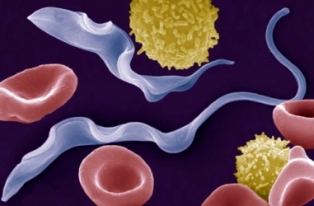Microglia in neuropathology caused by protozoan parasites
 Involvement of the central nervous system (CNS) is the most severe consequence of some parasitic infections. Protozoal infections comprise a group of diseases that together affect billions of people worldwide and, according to the World Health Organization, are responsible for more than 500000 deaths annually. They include African and American trypanosomiasis, leishmaniasis, malaria, toxoplasmosis, and amoebiasis. Mechanisms underlying invasion of the brain parenchyma by protozoa are not well understood and may depend on parasite nature: a vascular invasion route is most common. Immunosuppression favors parasite invasion into the CNS and therefore the host immune response plays a pivotal role in the development of a neuropathology in these infectious diseases. In the brain, microglia are the resident immune cells active in defense against pathogens that target the CNS. Beside their direct role in innate immunity, they also play a principal role in coordinating the trafficking and recruitment of other immune cells from the periphery to the CNS. Despite their evident involvement in the neuropathology of protozoan infections, little attention has given to microglia–parasite interactions. This review describes the most prominent features of microglial cells and protozoan parasites and summarizes the most recent information regarding the reaction of microglial cells to parasitic infections. We highlight the involvement of the periphery–brain axis and emphasize possible scenarios for microglia–parasite interactions.
Involvement of the central nervous system (CNS) is the most severe consequence of some parasitic infections. Protozoal infections comprise a group of diseases that together affect billions of people worldwide and, according to the World Health Organization, are responsible for more than 500000 deaths annually. They include African and American trypanosomiasis, leishmaniasis, malaria, toxoplasmosis, and amoebiasis. Mechanisms underlying invasion of the brain parenchyma by protozoa are not well understood and may depend on parasite nature: a vascular invasion route is most common. Immunosuppression favors parasite invasion into the CNS and therefore the host immune response plays a pivotal role in the development of a neuropathology in these infectious diseases. In the brain, microglia are the resident immune cells active in defense against pathogens that target the CNS. Beside their direct role in innate immunity, they also play a principal role in coordinating the trafficking and recruitment of other immune cells from the periphery to the CNS. Despite their evident involvement in the neuropathology of protozoan infections, little attention has given to microglia–parasite interactions. This review describes the most prominent features of microglial cells and protozoan parasites and summarizes the most recent information regarding the reaction of microglial cells to parasitic infections. We highlight the involvement of the periphery–brain axis and emphasize possible scenarios for microglia–parasite interactions.
see more: https://onlinelibrary.wiley.com/doi/epdf/10.1111/brv.12566
- 109 views
